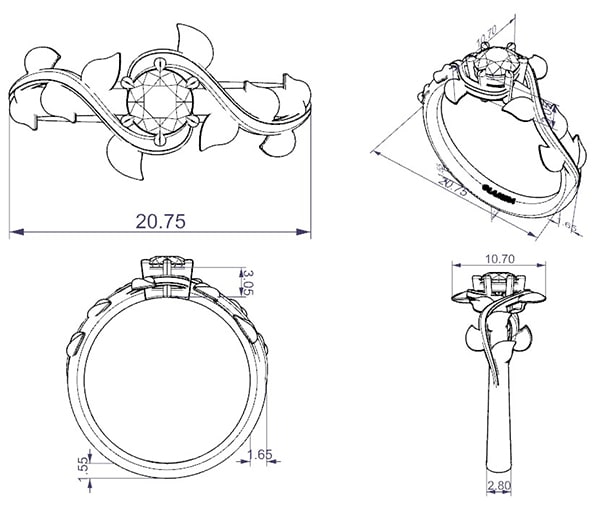
Engagement Ring Bagu
0.35 ct| Centre Stone | Green Tourmaline |
| Colour / Metal | 14k White Gold |
| GLAMIRA Logo inside | Yes |
| Rhodium Plated | Yes |
| Solid | Yes |
Free & secured delivery
60 Day Return Policy
3 Year Protection Plan
- :
Order Now, Gift Before Delivery
Read More
The centre stone, Green Tourmaline, is of the highest quality, with a clarity of AAA and a beautiful Green colour. The Very Good cut of the stone enhances its natural radiance, and with a total carat weight of 0.35, this truly is a statement piece that will capture the attention of all who gaze upon it.
In addition to the centre stone, the ring features 1 additional stones, all carefully selected and set to enhance the beauty of the piece. This is a ring that embodies elegance and sophistication, crafted to perfection for the woman who demands nothing but the best. Experience the luxury of our Engagement Ring Bagu ring today and add a touch of glamour to any outfit.
| Product No: | PR04 |
| Gender | Female |
| Solid | Yes |
| Colour / Metal | 14k White Gold |
| GLAMIRA Logo inside | Yes |
| Rhodium Plated | Yes |
| Comfort Fit | Yes |
| Product Dimensions | Click to View |
| Centre Stone | Green Tourmaline |
| Certification | GL Certified |
| Carat | 0.35 |
| Diameter | 4.5 mm |
| Shape | Round |
| Stone Clarity | AAA |
| Cut | Very Good |
| Colour | Green |
| Quantity of stones | 1 |


There are no reviews for this product yet.
Shipping details
- Estimated delivery time:
- Free shipping via:
- UPS
The timing is the keyword when it comes to organising a surprise for proposal or a wedding. GLAMIRA is proud to offer one of the fastest production and shipping time frames in the market.
We also offer free delivery to all orders. Furthermore, if you would like to keep your order as a surprise, simply select the option of anonymous packaging during the checkout and we will send your product in plain packaging with no GLAMIRA logo on it.
Other Options
- ShippingFree Shipping
- Anonymous PackagingAvailable
- EngravingFREE
- Gift BoxFREE

60 Day Return Policy We are committed to your satisfaction. Engraved or non-engraved; if you are not happy with your choice, return it in original condition within 60 days.

60 Day Resizing Policy Great things start with little details. GLAMIRA will assist you with keeping the secret of a surprise and resize your ring, one time, free of charge within the first 60 days of receipt.

Lifetime Warranty We stand behind the quality of our jewellery and provide lifetime warranty for all of our products. Every order is made and treated with care by our experts, from the very first second. Enjoy the quality of professional masterpiece and feel confident that your unique design jewelry will last a lifetime.

100% Satisfaction Oriented Customer Support GLAMIRA customer support team is happy to assist you throughout one of the most beautiful moments in your life. Our mission is your satisfaction; take your time to discover that perfect design, while we take care of everything else.

Custom-made jewellery with a unique product ID Your personalised product is a one-of-a-kind piece of jewellery. To show that, we put a unique product ID on every single product that we create especially for you. Your unique product ID is also an indication of your lifetime warranty.

Fast Delivery The timing is the keyword when it comes to organising a surprise for proposal or a wedding. GLAMIRA is proud to offer one of the fastest production and shipping time frames in the market.
We also offer free delivery to all orders. Furthermore, if you would like to keep your order as a surprise, simply select the option of anonymous packaging during the checkout and we will send your product in plain packaging with no GLAMIRA logo on it.
Authenticity Certificates for Diamonds and Gemstones Expert in-house gemologists carefully inspect all GLAMIRA diamonds & gemstones before they issue certificates for them. Every order comes with a certificate. If you are interested in GIA (Gemological Institute of America) certified diamonds, our customer support team will be more than happy to assist you.

Allergy-Free Material The finest quality metals and stones used in our production are allergy-free. When it comes to wearing jewelry, comfort is as important as the jewelry itself. Our goal is to make sure that your personalized, unique design jewelry not only looks good, but also feels comfortable.

Years of Experience Due to many years of professional attitude and striving to constantly improve our work, GLAMIRA has spread through many countries and have departments all around the world. Ordering from us assures a piece of jewellery that shows dedication to the field and years of experience.

Founded in Heilbronn - Germany, delivering top quality since 2008 GLAMIRA roots established in Germany makes us different from other jewelers because of two main keywords: quality and punctuality. Established and tested processes throughout years of professionalism and disciplinary allow us to offer top quality service and jewelery.

Direct from the source All gemstones and jewelry. Every step in a typical retail model influences the final price of the product. We are the manufacturer, covering all the phases involved in the process, from the very first touch of pen on the paper, till the product is handed to a courier. By refraining from dealers, importers, wholesalers and high street stores we are able to bring massive savings to our customers.

Conflict free diamonds, gemstones and metals Precious metals and stones are often mined under horrendous conditions around the world. At GLAMIRA we guarantee that all diamonds, gemstones and metals used in the production of our jewellery are conflict free, originating from ethical sources and violence free regions in compliance with the Kimberley Process.
Profile A - Traditional Comfort Fit
The edge of the ring is rounded inside as well as outside.
Profile B - Flat Band Comfort Fit
The edge of the ring is rounded inside and flat outside with a slight dome for increased comfort.
Profile C - Concave Comfort Fit
The edge of the ring is curved outside for a stylish look and rounded inside for increased comfort.
Polished
Bright and reflective finish. It is a good way to showcase the metal. Also known as bright finish.
Wire Brushed (Ice Matte)
Non-reflective finish with deeper brush strokes.
Horizontal Brushed (Matte)
Non-reflective finish with a linear brush texture. This type of finish reduces the reflectivity of the metal.
Sandblasted
A coarse finish with a grainy texture. It provides a special effect when used together with polished finish.
Vertical Brushed (Matte)
Non-reflective finish with a vertical brush texture. This type of finish reduces the reflectivity of the metal. It provides a chic look when used together with polished finish.
Polished
Bright and reflective finish. It is a good way to showcase the metal. Also known as bright finish.
Diagonal Textured Finish
Non-reflective finish with texture of diagonal strokes.
Polished
Bright and reflective finish. It is a good way to showcase the metal. Also known as bright finish.
Vertically Matte
Non-reflective finish with a vertical brush texture. This type of finish reduces the reflectivity of the metal. It provides a chic look when used together with polished finish.
Polished
Bright and reflective finish. It is a good way to showcase the metal. Also known as bright finish
Horizantly Matte
Non-reflective finish with a linear brush texture. This type of finish reduces the reflectivity of the metal.
Polished
Bright and reflective finish. It is a good way to showcase the metal. Also known as bright finish
Ice Matte
Non-reflective finish with deeper brush strokes.
Polished
Bright and reflective finish. It is a good way to showcase the metal. Also known as bright finish
Sandy Matte
A coarse finish with a grainy texture. It provides a special effect when used together with polished finish.
The
Lab created
Stones
Extraordinary and as beautiful as natural stone jewellery… Lab-created diamonds and precious stones are the latest trend in jewellery to reflect your great sense and feelings.
Selected quality will not appear on product image.









